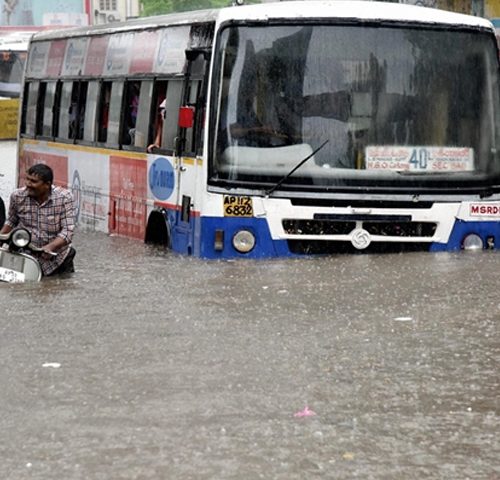Floods are not something one normally associates with Hyderabad. We are residents who have become used to being water-deprived and pining for that extra bucket of water, but October 2nd changed all that.
The city was caught unawares as torrential rains in the evening hours caused havoc on all the residents. Weather experts say that the city witnessed a cloudburst, with many areas of the city recording between 7 cms. and 12 cms. of rainfall that submerged several low-lying colonies. Since it was a public holiday due to Gandhi Jayanthi, the traffic on the roads was much less than normal, yet many people were stuck on the roads for almost four hours. The Punjagutta flyover which connects Begumpet to Banjara Hills and Jubilee Hills was knee-deep in water and the whole of Hyderabad was left wondering how a flyover could get flooded. In Banjara Hills, a wall collapsed killing two people, while one person died of electrocution in Hussaini Alam in the old city area.
Climate change has led to a lot of extreme weather with droughts being as severe as the rains, leading to a state of perpetual suffering for the urban population. Chennai, Bengaluru, Mumbai, Ahmedabad and Hyderabad have recently seen many instances of extreme rainfall leading to destructive flooding. Since population and financial investment in these urban areas is so high, being unprepared for such calamities is devastating. Most large cities are unprepared for extreme flooding and while weather reports can predict rain, it cannot give us an accurate account of the intensity of the rainfall. Scientists are of the opinion that climate change caused by greenhouse gases will cause more high intensity rainfall in future years. Preparing our urban centers for this has become crucial.
City officials say that even though the intensity and impact of excessive rain and flooding cannot be predicted, every city can take measures to prevent flooding from becoming worse. Some points to keep in mind:
Take the 3 Rs seriously: Reduce Recycle Reuse.
Reduce the use of plastics or at least recycle and reuse them instead of throwing them in the garbage. Plastics tend to float and get carried away with the water. They later get mixed with mud and stones and block drains which worsens the flooding situation.
Separate sewage for storm water drains.
Storm water drains also carry sewage sometimes so it becomes difficult to divert excess storm water into lakes. Also, storm water drains should be regularly cleared of solid debris and garbage that can clog them and exacerbate the flooding situation. When there are separate drains for rain water and sewage, rain water can be diverted into lakes without polluting them.
Regular sweeping and appropriate disposal of waste.
Sanitation workers should sweep roads and collect the soil and dead leaves and dispose these in an appropriate manner. Simply sweeping and piling up the waste in small piles serves no purpose and obstructs drains in the rains.
Keep open spaces open.
As far as possible, open spaces should be laid with gravel, grass or loose tiles and not with concrete or tarmac. Regular land is able to absorbs almost 80% of rainwater but urban areas have been cemented and concretised to such an extent that there is little scope of water seeping into the ground and replenishing the groundwater. There are two negative consequences to this: increased flooding and waste of precious rainwater that could have recharged the water table below.
Strict regulation of construction near water bodies.
There should be strict regulation of construction near water bodies. Many buildings in urban areas are encroaching in the spaces of lakes and other water bodies. When it rains heavily, water will inevitably enter houses that have been illegally constructed in these areas.
Without redesigning the existing infrastructure and preparing for extreme weather, India’s cities will continue to suffer the consequences of unrelenting rains and endanger lives and property.




